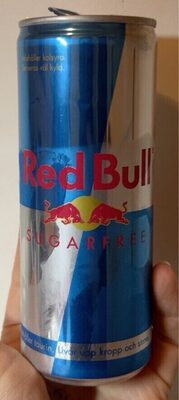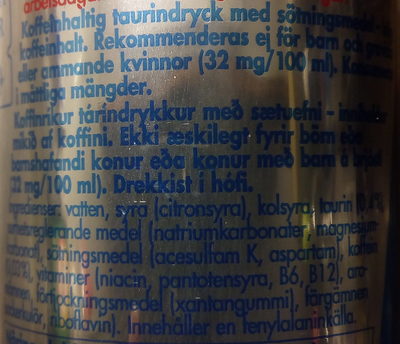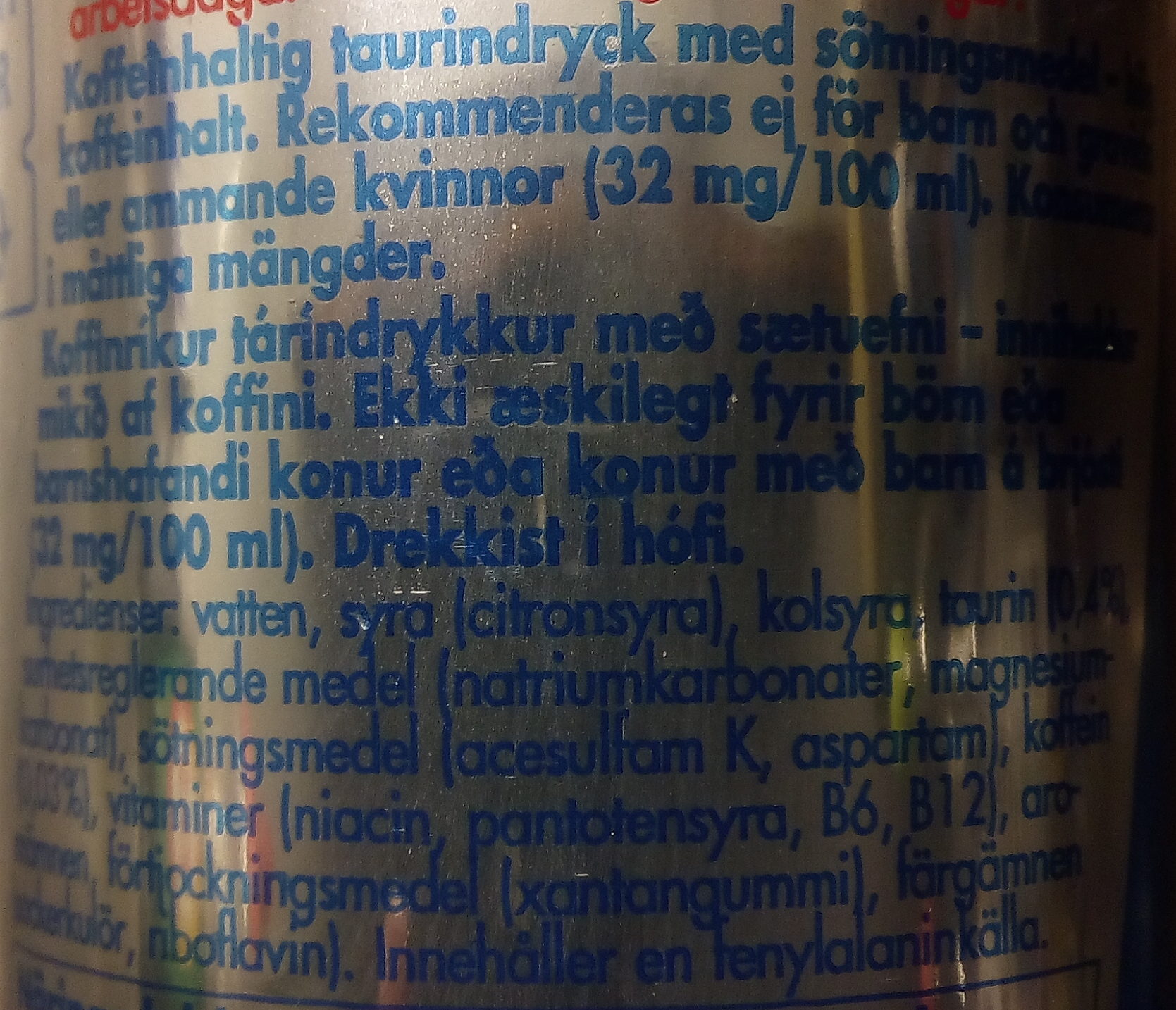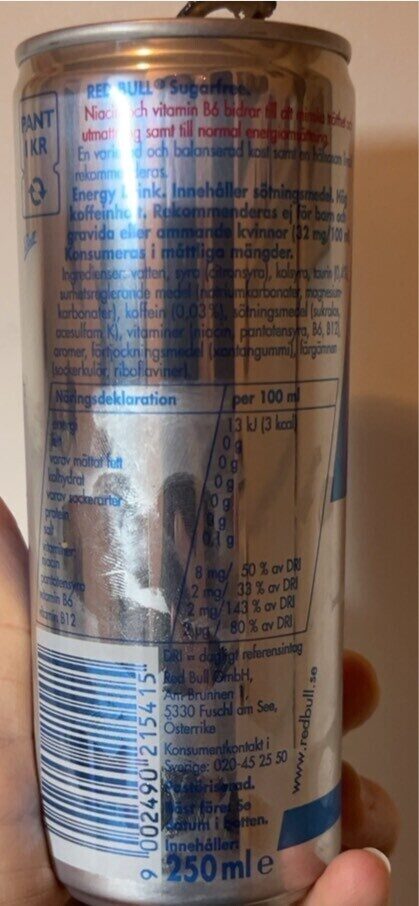Help us make food transparency the norm!
As a non-profit organization, we depend on your donations to continue informing consumers around the world about what they eat.
The food revolution starts with you!
Red Bull Sugarfree - 250 ml
Red Bull Sugarfree - 250 ml
This product page is not complete. You can help to complete it by editing it and adding more data from the photos we have, or by taking more photos using the app for Android or iPhone/iPad. Thank you!
×
Streckkod: 9002490215415 (EAN / EAN-13)
Vanligt namn: Koffeinhaltig taurindryck med sötningsmedel
Kvantitet: 250 ml
Förpackning: en:Metal, Återvinningsbara metaller, Aluminium
Varumärken: Red Bull
Kategorier: Drycker, Kolsyrade Drycker, en:Artificially sweetened beverages, Energidrycker
Etiketter, certifieringar, utmärkelser: en:Not advised for specific people, en:Not advised for children and pregnant women
Länk till produktsidan på producentens officiella webbplats: http://energydrink-se.redbull.com/red-bu...
Butiker: Frendo
Länder där såld: Sverige
Matching with your preferences
Hälsa
Ingredienser
-
23 ingredienser
Vatten, syra (citronsyra), kolsyra, taurin 0,4%, surhetsreglerande medel (natriumkarbonater, magnesiumkarbonat), sötningsmedel (acesulfam K, aspartam), koffein, vitaminer (niacin 0,002%, pantotensyra 0,002%, B6 0,002%, B12), aromämnen, förtjockningsmedel (xantangummi), färgämnen (sockerkulör, riboflavin).
Food processing
-
Ultra processed foods
Elements that indicate the product is in the 4 - Ultra bearbetade livsmedel och drycker group:
- Tillsats: E101 - Riboflavin
- Tillsats: E150a - Sockerkulör
- Tillsats: E290 - Koldioxid
- Tillsats: E415 - Xantangummi
- Tillsats: E950 - Acesulfam k
- Tillsats: E951 - Aspartam
- Ingrediens: Färg
- Ingrediens: Arom
- Ingrediens: Sötningsmedel
- Ingrediens: Förtjockningsmedel
Food products are classified into 4 groups according to their degree of processing:
- Obearbetade eller minimalt bearbetade livsmedel
- Bearbetade kulinariska ingredienser
- Halvfabrikat
- Ultra processed foods
The determination of the group is based on the category of the product and on the ingredients it contains.
Tillsatser
-
E101 - Riboflavin
Riboflavin: Riboflavin, also known as vitamin B2, is a vitamin found in food and used as a dietary supplement. Food sources include eggs, green vegetables, milk and other dairy product, meat, mushrooms, and almonds. Some countries require its addition to grains. As a supplement it is used to prevent and treat riboflavin deficiency and prevent migraines. It may be given by mouth or injection.It is nearly always well tolerated. Normal doses are safe during pregnancy. Riboflavin is in the vitamin B group. It is required by the body for cellular respiration.Riboflavin was discovered in 1920, isolated in 1933, and first made in 1935. It is on the World Health Organization's List of Essential Medicines, the most effective and safe medicines needed in a health system. Riboflavin is available as a generic medication and over the counter. In the United States a month of supplements costs less than 25 USD.Källa: Wikipedia (Engelska)
-
E101i - Riboflavin
Riboflavin: Riboflavin, also known as vitamin B2, is a vitamin found in food and used as a dietary supplement. Food sources include eggs, green vegetables, milk and other dairy product, meat, mushrooms, and almonds. Some countries require its addition to grains. As a supplement it is used to prevent and treat riboflavin deficiency and prevent migraines. It may be given by mouth or injection.It is nearly always well tolerated. Normal doses are safe during pregnancy. Riboflavin is in the vitamin B group. It is required by the body for cellular respiration.Riboflavin was discovered in 1920, isolated in 1933, and first made in 1935. It is on the World Health Organization's List of Essential Medicines, the most effective and safe medicines needed in a health system. Riboflavin is available as a generic medication and over the counter. In the United States a month of supplements costs less than 25 USD.Källa: Wikipedia (Engelska)
-
E290 - Koldioxid
Carbon dioxide: Carbon dioxide -chemical formula CO2- is a colorless gas with a density about 60% higher than that of dry air. Carbon dioxide consists of a carbon atom covalently double bonded to two oxygen atoms. It occurs naturally in Earth's atmosphere as a trace gas. The current concentration is about 0.04% -410 ppm- by volume, having risen from pre-industrial levels of 280 ppm. Natural sources include volcanoes, hot springs and geysers, and it is freed from carbonate rocks by dissolution in water and acids. Because carbon dioxide is soluble in water, it occurs naturally in groundwater, rivers and lakes, ice caps, glaciers and seawater. It is present in deposits of petroleum and natural gas. Carbon dioxide is odorless at normally encountered concentrations, however, at high concentrations, it has a sharp and acidic odor.As the source of available carbon in the carbon cycle, atmospheric carbon dioxide is the primary carbon source for life on Earth and its concentration in Earth's pre-industrial atmosphere since late in the Precambrian has been regulated by photosynthetic organisms and geological phenomena. Plants, algae and cyanobacteria use light energy to photosynthesize carbohydrate from carbon dioxide and water, with oxygen produced as a waste product.CO2 is produced by all aerobic organisms when they metabolize carbohydrates and lipids to produce energy by respiration. It is returned to water via the gills of fish and to the air via the lungs of air-breathing land animals, including humans. Carbon dioxide is produced during the processes of decay of organic materials and the fermentation of sugars in bread, beer and wine making. It is produced by combustion of wood and other organic materials and fossil fuels such as coal, peat, petroleum and natural gas. It is an unwanted byproduct in many large scale oxidation processes, for example, in the production of acrylic acid -over 5 million tons/year-.It is a versatile industrial material, used, for example, as an inert gas in welding and fire extinguishers, as a pressurizing gas in air guns and oil recovery, as a chemical feedstock and as a supercritical fluid solvent in decaffeination of coffee and supercritical drying. It is added to drinking water and carbonated beverages including beer and sparkling wine to add effervescence. The frozen solid form of CO2, known as dry ice is used as a refrigerant and as an abrasive in dry-ice blasting. Carbon dioxide is the most significant long-lived greenhouse gas in Earth's atmosphere. Since the Industrial Revolution anthropogenic emissions – primarily from use of fossil fuels and deforestation – have rapidly increased its concentration in the atmosphere, leading to global warming. Carbon dioxide also causes ocean acidification because it dissolves in water to form carbonic acid.Källa: Wikipedia (Engelska)
-
E330 - Citronsyra
Citric acid: Citric acid is a weak organic acid that has the chemical formula C6H8O7. It occurs naturally in citrus fruits. In biochemistry, it is an intermediate in the citric acid cycle, which occurs in the metabolism of all aerobic organisms. More than a million tons of citric acid are manufactured every year. It is used widely as an acidifier, as a flavoring and chelating agent.A citrate is a derivative of citric acid; that is, the salts, esters, and the polyatomic anion found in solution. An example of the former, a salt is trisodium citrate; an ester is triethyl citrate. When part of a salt, the formula of the citrate ion is written as C6H5O3−7 or C3H5O-COO-3−3.Källa: Wikipedia (Engelska)
-
E415 - Xantangummi
Xanthan gum: Xanthan gum -- is a polysaccharide with many industrial uses, including as a common food additive. It is an effective thickening agent and stabilizer to prevent ingredients from separating. It can be produced from simple sugars using a fermentation process, and derives its name from the species of bacteria used, Xanthomonas campestris.Källa: Wikipedia (Engelska)
-
E500 - Natriumkarbonater
Sodium carbonate: Sodium carbonate, Na2CO3, -also known as washing soda, soda ash and soda crystals, and in the monohydrate form as crystal carbonate- is the water-soluble sodium salt of carbonic acid. It most commonly occurs as a crystalline decahydrate, which readily effloresces to form a white powder, the monohydrate. Pure sodium carbonate is a white, odorless powder that is hygroscopic -absorbs moisture from the air-. It has a strongly alkaline taste, and forms a moderately basic solution in water. Sodium carbonate is well known domestically for its everyday use as a water softener. Historically it was extracted from the ashes of plants growing in sodium-rich soils, such as vegetation from the Middle East, kelp from Scotland and seaweed from Spain. Because the ashes of these sodium-rich plants were noticeably different from ashes of timber -used to create potash-, they became known as "soda ash". It is synthetically produced in large quantities from salt -sodium chloride- and limestone by a method known as the Solvay process. The manufacture of glass is one of the most important uses of sodium carbonate. Sodium carbonate acts as a flux for silica, lowering the melting point of the mixture to something achievable without special materials. This "soda glass" is mildly water-soluble, so some calcium carbonate is added to the melt mixture to make the glass produced insoluble. This type of glass is known as soda lime glass: "soda" for the sodium carbonate and "lime" for the calcium carbonate. Soda lime glass has been the most common form of glass for centuries. Sodium carbonate is also used as a relatively strong base in various settings. For example, it is used as a pH regulator to maintain stable alkaline conditions necessary for the action of the majority of photographic film developing agents. It acts as an alkali because when dissolved in water, it dissociates into the weak acid: carbonic acid and the strong alkali: sodium hydroxide. This gives sodium carbonate in solution the ability to attack metals such as aluminium with the release of hydrogen gas.It is a common additive in swimming pools used to raise the pH which can be lowered by chlorine tablets and other additives which contain acids. In cooking, it is sometimes used in place of sodium hydroxide for lyeing, especially with German pretzels and lye rolls. These dishes are treated with a solution of an alkaline substance to change the pH of the surface of the food and improve browning. In taxidermy, sodium carbonate added to boiling water will remove flesh from the bones of animal carcasses for trophy mounting or educational display. In chemistry, it is often used as an electrolyte. Electrolytes are usually salt-based, and sodium carbonate acts as a very good conductor in the process of electrolysis. In addition, unlike chloride ions, which form chlorine gas, carbonate ions are not corrosive to the anodes. It is also used as a primary standard for acid-base titrations because it is solid and air-stable, making it easy to weigh accurately.Källa: Wikipedia (Engelska)
-
E504 - Magnesiumkarbonater
Magnesium carbonate: Magnesium carbonate, MgCO3 -archaic name magnesia alba-, is an inorganic salt that is a white solid. Several hydrated and basic forms of magnesium carbonate also exist as minerals.Källa: Wikipedia (Engelska)
-
E504i - Magnesiumkarbonat
Magnesium carbonate: Magnesium carbonate, MgCO3 -archaic name magnesia alba-, is an inorganic salt that is a white solid. Several hydrated and basic forms of magnesium carbonate also exist as minerals.Källa: Wikipedia (Engelska)
-
E950 - Acesulfam k
Acesulfame potassium: Acesulfame potassium - AY-see-SUL-faym-, also known as acesulfame K -K is the symbol for potassium- or Ace K, is a calorie-free sugar substitute -artificial sweetener- often marketed under the trade names Sunett and Sweet One. In the European Union, it is known under the E number -additive code- E950. It was discovered accidentally in 1967 by German chemist Karl Clauss at Hoechst AG -now Nutrinova-. In chemical structure, acesulfame potassium is the potassium salt of 6-methyl-1‚2,3-oxathiazine-4-3H--one 2‚2-dioxide. It is a white crystalline powder with molecular formula C4H4KNO4S and a molecular weight of 201.24 g/mol.Källa: Wikipedia (Engelska)
-
E951 - Aspartam
Aspartame: Aspartame -APM- is an artificial non-saccharide sweetener used as a sugar substitute in some foods and beverages. In the European Union, it is codified as E951. Aspartame is a methyl ester of the aspartic acid/phenylalanine dipeptide. A panel of experts set up by the European Food Safety Authority concluded in 2013 that aspartame is safe for human consumption at current levels of exposure. As of 2018, evidence does not support a long-term benefit for weight loss or in diabetes. Because its breakdown products include phenylalanine, people with the genetic condition phenylketonuria -PKU- must be aware of this as an additional source.It was first sold under the brand name NutraSweet. It was first made in 1965, and the patent expired in 1992. It was initially approved for use in food products by the U.S. Food and Drug Administration -FDA- in 1981. The safety of aspartame has been the subject of several political and medical controversies, United States congressional hearings, and Internet hoaxes.Källa: Wikipedia (Engelska)
Ingrediensanalys
-
Palmoljefri
No ingredients containing palm oil detected
-
Vegansk status okänd
Okända ingredienser: Kobalamin
-
Vegetarisk status okänd
Okända ingredienser: Kobalamin
-
Details of the analysis of the ingredients
sv: Vatten, syra (citronsyra), kolsyra, taurin 0.4%, surhetsreglerande medel (natriumkarbonater, magnesiumkarbonat), sötningsmedel (acesulfam K, aspartam), koffein, vitaminer (niacin 0.002%, pantotensyra 0.002%, B6 0.002%, B12), aromämnen, förtjockningsmedel (xantangummi), färgämnen (sockerkulör, riboflavin)- Vatten -> en:water - vegan: yes - vegetarian: yes - ciqual_food_code: 18066 - percent_min: 15.568 - percent_max: 98.8
- syra -> en:acid - percent_min: 0.4 - percent_max: 49.6
- citronsyra -> en:e330 - vegan: yes - vegetarian: yes - percent_min: 0.4 - percent_max: 49.6
- kolsyra -> en:e290 - vegan: yes - vegetarian: yes - percent_min: 0.4 - percent_max: 33.2
- taurin -> en:taurine - vegan: maybe - vegetarian: maybe - percent_min: 0.4 - percent: 0.4 - percent_max: 0.4
- surhetsreglerande medel -> en:acidity-regulator - percent_min: 0 - percent_max: 0.4
- natriumkarbonater -> en:e500 - vegan: yes - vegetarian: yes - percent_min: 0 - percent_max: 0.4
- magnesiumkarbonat -> en:e504i - vegan: yes - vegetarian: yes - percent_min: 0 - percent_max: 0.2
- sötningsmedel -> en:sweetener - percent_min: 0 - percent_max: 0.4
- acesulfam K -> en:e950 - vegan: yes - vegetarian: yes - percent_min: 0 - percent_max: 0.4
- aspartam -> en:e951 - vegan: yes - vegetarian: yes - percent_min: 0 - percent_max: 0.2
- koffein -> en:caffeine - vegan: yes - vegetarian: yes - percent_min: 0 - percent_max: 0.4
- vitaminer -> en:vitamins - vegan: yes - vegetarian: yes - percent_min: 0 - percent_max: 0.008
- niacin -> en:e375 - vegan: maybe - vegetarian: maybe - percent_min: 0.002 - percent: 0.002 - percent_max: 0.002
- pantotensyra -> en:pantothenic-acid - vegan: yes - vegetarian: yes - percent_min: 0.002 - percent: 0.002 - percent_max: 0.002
- B6 -> en:vitamin-b6 - vegan: yes - vegetarian: yes - percent_min: 0.002 - percent: 0.002 - percent_max: 0.002
- B12 -> en:vitamin-b12 - percent_min: 0 - percent_max: 0.002
- aromämnen -> en:flavouring - vegan: maybe - vegetarian: maybe - percent_min: 0 - percent_max: 0.008
- förtjockningsmedel -> en:thickener - percent_min: 0 - percent_max: 0.008
- xantangummi -> en:e415 - vegan: yes - vegetarian: yes - percent_min: 0 - percent_max: 0.008
- färgämnen -> en:colour - percent_min: 0 - percent_max: 0.008
- sockerkulör -> en:e150a - vegan: yes - vegetarian: yes - percent_min: 0 - percent_max: 0.008
- riboflavin -> en:e101 - vegan: maybe - vegetarian: yes - percent_min: 0 - percent_max: 0.008
Näring
-
Good nutritional quality
⚠ ️Warning: the amount of fruits, vegetables and nuts is not specified on the label, it was estimated from the list of ingredients: 0This product is considered a beverage for the calculation of the Nutri-Score.
Positiva poäng: 0
- Proteiner: 0 / 5 (värde: 0, avrundat värde: 0)
- Fiber: 0 / 5 (värde: 0, avrundat värde: 0)
- Frukt, grönsaker, nötter och raps- / valnöt- / olivoljor: 0 / 10 (värde: 0, avrundat värde: 0)
Negativa poäng: 1
- Energi: 1 / 10 (värde: 13, avrundat värde: 13)
- Socker: 0 / 10 (värde: 0, avrundat värde: 0)
- Mättat fett: 0 / 10 (värde: 0, avrundat värde: 0)
- Natrium: 0 / 10 (värde: 40, avrundat värde: 40)
The points for proteins are counted because the negative points are less than 11.
Näringsvärde: (1 - 0)
Nutri-Score:
-
Näringsvärden
-
Fett i låg kvantitet (0%)
What you need to know- A high consumption of fat, especially saturated fats, can raise cholesterol, which increases the risk of heart diseases.
Recommendation: Limit the consumption of fat and saturated fat- Choose products with lower fat and saturated fat content.
-
Mättat fett i låg kvantitet (0%)
What you need to know- A high consumption of fat, especially saturated fats, can raise cholesterol, which increases the risk of heart diseases.
Recommendation: Limit the consumption of fat and saturated fat- Choose products with lower fat and saturated fat content.
-
Sockerarter i låg kvantitet (0%)
What you need to know- A high consumption of sugar can cause weight gain and tooth decay. It also augments the risk of type 2 diabetes and cardio-vascular diseases.
Recommendation: Limit the consumption of sugar and sugary drinks- Sugary drinks (such as sodas, fruit beverages, and fruit juices and nectars) should be limited as much as possible (no more than 1 glass a day).
- Choose products with lower sugar content and reduce the consumption of products with added sugars.
-
Salt i låg kvantitet (0.1%)
What you need to know- A high consumption of salt (or sodium) can cause raised blood pressure, which can increase the risk of heart disease and stroke.
- Many people who have high blood pressure do not know it, as there are often no symptoms.
- Most people consume too much salt (on average 9 to 12 grams per day), around twice the recommended maximum level of intake.
Recommendation: Limit the consumption of salt and salted food- Reduce the quantity of salt used when cooking, and don't salt again at the table.
- Limit the consumption of salty snacks and choose products with lower salt content.
-
-
Näringsfakta
Näringsfakta Som såld
för 100 g / 100 mlCompared to: Energidrycker Energi 13 kj
(3 kcal)−83 % Fett 0 g −100 % Mättat fett 0 g −100 % Kolhydrat 0 g −100 % Sockerarter 0 g −100 % Fiber 0 g −100 % Protein 0 g −100 % Salt 0,1 g +10 % Vitamin B5 (Pantotensyra) 2 mg −33 % Koffein 32 mg - Fruits‚ vegetables‚ nuts and rapeseed‚ walnut and olive oils (estimate from ingredients list analysis) 0 % Vitamin-b6-pyridoxin 2 mg Vitamin-b12-cobalamin 2 µg Vitamin-b3-vitamin-pp-niacin 8 mg
Miljö
-
Eco-Score not yet applicable
Not yet applicable for the category: Energidrycker
The Eco-Score is not yet applicable for this category, but we are working on adding support for it.
Förpackning
-
Packaging with a low impact
-
Packaging parts
(Aluminium)
-
Packaging materials
Material % Packaging weight Packaging weight per 100 g of product Metal
-
Transportation
-
Origins of ingredients
Missing origins of ingredients information
⚠ ️ The origins of the ingredients of this product are not indicated.
If they are indicated on the packaging, you can modify the product sheet and add them.
If you are the manufacturer of this product, you can send us the information with our free platform for producers.Add the origins of ingredients for this product Add the origins of ingredients for this product
Report a problem
-
Incomplete or incorrect information?
Category, labels, ingredients, allergens, nutritional information, photos etc.
If the information does not match the information on the packaging, please complete or correct it. Open Food Facts is a collaborative database, and every contribution is useful for all.
Datakällor
Produkt tillagd den av olofolleola4
Senast ändrad produktsida på av kiliweb.
Produktsida också redigerad av openfoodfacts-contributors, packbot, yuka.sY2b0xO6T85zoF3NwEKvllUcQ4SCjmOUETnmi1_V68ygIr_KQ88o2aTraas.









